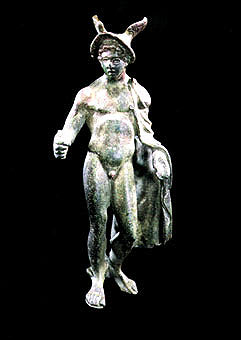Greco-Roman Bronze Sculpture of Hermes, 200 BCE - 200 CE
Bronze
6
PF.5471
Further images
Swift footed, Hermes (known to Romans as Mercury), the messenger of Zeus and herald to the gods, was the patron deity of travelers, gamblers, tricksters, and businessmen. To him is...
Swift footed, Hermes (known to Romans as Mercury), the messenger of Zeus and herald to the gods, was the patron deity of travelers, gamblers, tricksters, and businessmen. To him is ascribed the introduction of deploying embassies in the capitals of foreign empires in order to broker peace through diplomatic channels instead of war. Hermes, the robber and cattle driver, the prince of thieves at the gates, the bringer of dreams, the patron of travelers, is also credited with assiting the Fates during the creation of the alphabet, securing his role as the governor of the tongue and the guide of intelligent speech. He also invented the lyre from a tortoise shell and gave this musical instrument to Apollo who, in turn, gave Mercury a caduceus, the golden staff crowned by wings and intertwined with serpents--symbol of today's medical profession. Hermes is sometimes called Argiphontes, for having killed the all-seeing Argos I who guarded Io. He is referred to as Psychopompus in the context of his role as the guide of the souls of the deceased to the Underworld.
Here, Hermes stands nude in a classic contraposto pose with his weight resting on his right leg, leaving his left leg relaxed with his knee slightly bent. A piece of drapery flows across his chest and falls along his left arm. His head is angled down and slightly to the right. Hermes’ identity is confirmed by the presence of three of his most notable attributes: the petasus, the talarius, and the money sack. The petasus is a wide brimmed hat characteristic of travelers; here, it is winged, indicating Mercury’s swiftness and symbolizing his wisdom. The talarius is the pair of sandals, again winged, and again symbolizing the god’s swiftness. In his right hand, he carries a money sack, a symbol of promised prosperity.
This magnificent bronze sculpture exemplifies the artistic creativity of the Hellenistic era. The statue was cast from bronze using the solid cast lost wax process. This technique starts with a solid wax model of the object on which every detail of the finished product is represented. The model is covered in clay and baked. During the firing, the wax melts and drains out from the clay, leaving behind a mold into which molten bronze is poured. Finally, the mold is broken, the sculpture removed and polished, smoothing out any imperfections in the surface. The sculptor of this work was certainly inspired by a work of the great master Lysippos, the court artist of Alexander the Great. Although Lysippos’ creation no longer exists, we are aware of its composition from later Roman copies, including the Farnes-Andros Hermes that today resides in the Vatican Museum.
No doubt this gorgeous work of art was revered in its own time. Libations of rich wines and perfumed oils might have been placed nearby to honor the invoked deity. However, while the great pantheon of Greek and Roman gods and goddesses has faded into the realm of myth, this sculpture still stands as a stunning work of timeless beauty. Who knows, maybe this work will conjure up the spirit of Mercury, who might bless us with successful business dealings and safe travel? In our world – as in antiquity – this seems the ideal work of art for someone who charts a swift and successful course through time.
Here, Hermes stands nude in a classic contraposto pose with his weight resting on his right leg, leaving his left leg relaxed with his knee slightly bent. A piece of drapery flows across his chest and falls along his left arm. His head is angled down and slightly to the right. Hermes’ identity is confirmed by the presence of three of his most notable attributes: the petasus, the talarius, and the money sack. The petasus is a wide brimmed hat characteristic of travelers; here, it is winged, indicating Mercury’s swiftness and symbolizing his wisdom. The talarius is the pair of sandals, again winged, and again symbolizing the god’s swiftness. In his right hand, he carries a money sack, a symbol of promised prosperity.
This magnificent bronze sculpture exemplifies the artistic creativity of the Hellenistic era. The statue was cast from bronze using the solid cast lost wax process. This technique starts with a solid wax model of the object on which every detail of the finished product is represented. The model is covered in clay and baked. During the firing, the wax melts and drains out from the clay, leaving behind a mold into which molten bronze is poured. Finally, the mold is broken, the sculpture removed and polished, smoothing out any imperfections in the surface. The sculptor of this work was certainly inspired by a work of the great master Lysippos, the court artist of Alexander the Great. Although Lysippos’ creation no longer exists, we are aware of its composition from later Roman copies, including the Farnes-Andros Hermes that today resides in the Vatican Museum.
No doubt this gorgeous work of art was revered in its own time. Libations of rich wines and perfumed oils might have been placed nearby to honor the invoked deity. However, while the great pantheon of Greek and Roman gods and goddesses has faded into the realm of myth, this sculpture still stands as a stunning work of timeless beauty. Who knows, maybe this work will conjure up the spirit of Mercury, who might bless us with successful business dealings and safe travel? In our world – as in antiquity – this seems the ideal work of art for someone who charts a swift and successful course through time.
Literature
V26











